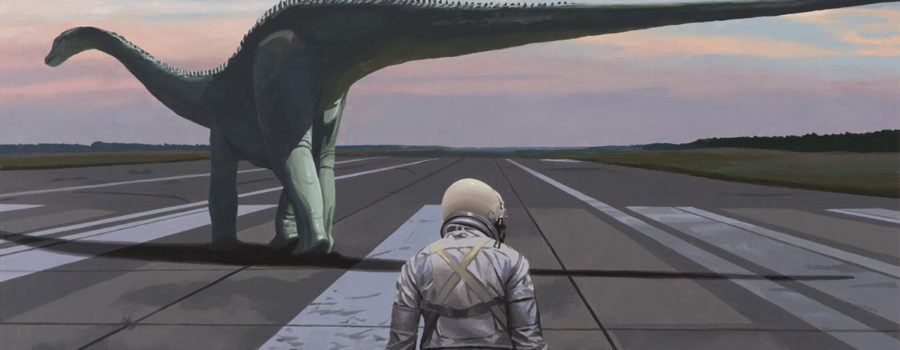“I was a doodler.” – Scott Listfield
Like many kids, Scott Listfield grew up with a Crayola box by his side, but unlike many of us who constantly drew the cliche square house with the triangle roof, and the sun in the corner – Scott’s doodles showed promise. As he got older, his passion for drawing this and that grew, “I usually scribbled away in the margins of the notes for whatever class I was supposed to be taking at the time.”
Later he went on to art school and after realizing art didn’t have to be so serious, he started to draw things he liked instead of what was “expected.” Thus came Astronaut Dinosaur. A series and style all his own, Astronaut Dinosaur brings to life a world similar to our own with some twists from the perspective of an astronaut just taking it all in. We talked to Scott about the series, his new book, and more in this hearty back and forth.
Kendra: Knowing what you know now about the art world and being a working artist, what’s a lesson you wish they’d implement in art school that’s still MIA?
Scott Listfield: Well it’s been a long time since I’ve been in school, so I’m not sure what’s in the curriculum these days. But a million years ago when I was still a student, I wouldn’t say they did the best job preparing us for what it takes to be an actual working artist. They taught me to paint, at least a bit, and they taught me to think, which is pretty valuable, and then they gave me some quick advice on the way out the door that was maybe 30 years out of date. And then I was left to fail my way (repeatedly) into figuring out the rest. Which to be honest, is probably how I learn best anyways, but maybe a couple of more timely pointers might have been helpful.
Of course, I now know people who are art professors, and many of them do an excellent job preparing their students. But when I talk to younger artists, which I do from time to time, it sounds to me like this is still, for the most part, a bit lacking in their education. For the most part, in art, there’s no one obvious path to success. If you talk to 100 artists, they took 100 different roads to get to where they are. It’s hard to generalize that enough to teach it to young art students, but I do think there are ways to go about it. Like, say, by bringing in artists outside the academic world to talk to your class about how they handle the business side of things. You know, I might be available.

Kendra: Your work centers around an astronaut roaming around in present-day and occasionally he runs up on a dinosaur here and there. Those are two things I feel like we absolutely become obsessed with as kids. Is that when space and dinos came into play for you or were these ideas developed into your work as you got older?
Scott Listfield: When I was a kid, the very first thing I remember wanting to be when I grew up was an astronaut. I know that’s the case for many people of my generation. And yeah, I was also super into dinosaurs too when I was a kid.
Later on, when I got out of college, I felt this enormous pressure that art had to be very serious and very important and it left me kind of burnt out, confused, and not wanting to make art. And so instead of thinking about all of the very famous artists, I learned about in school, and the important work they did, I instead watched lots of movies like Jurassic Park, Star Wars, and 2001.
I began to realize that much of my youth was spent thinking I’d grow up into a future filled with flying cars, robot best friends, and regular jaunts to the moon. Of the course, the future I grew into didn’t quite resemble this vision, but I immediately loved the idea of making paintings about the future I thought we’d get. So I started painting an astronaut wandering around to observe the world I lived in. What started as a kind of juvenile impulse soon became something with a surprising amount of depth to it. I could project a lot of things onto this astronaut, and I could send it wherever I wanted. It felt kind of stupid at the time, but it definitely ended up being accidentally pretty smart.
Kendra: Pop culture plays a big part in your work as well and you’ve just talked about 2001: A Space Odyssey, and have mentioned the likes of Lost In Space, The Jetsons before and how people had this keen fascination with the future back in the day. However, it seems like in recent years we’ve had this upswing of apocalyptic shows and movies. Do you feel that showcases a society that has lost hope in what the future may hold?
Scott Listfield: I’m no sociologist, but I do think that our ideas of a utopian space-age back in the ‘50s and ‘60s, which manifested itself in everything from cartoons to automobile designs to the architecture of diners, kind of quickly faded away. It feels very quaint now. It was perhaps obvious in real-time that flying to the moon wasn’t going to solve all the world’s problems, and from there it was probably easy to imagine how all the horrible things we were doing to the world, and ourselves, might, in the end, lead to some kind of dystopian future.
I can’t say whether there’s more of that kind of thing now than there was back then, but I do think some of the very best science fiction has dealt with such themes. But I don’t know that it necessarily means we’ve lost hope. I paint a lot of apocalyptic scenes in my work, and I think of them as just one vision of what the world might look like, and the power in them lies in our ability to change that future, to steer ourselves away from an apocalypse, while we still have the time. I mean, at least I hope we do.

Kendra: Let’s talk about your book! Astronaut contains nine chapters and all of your work up until it was sent to print. Are we getting this astronauts backstory in any of these chapters because when I see your work, I imagine they’re from another planet exploring America in 2019?
Scott Listfield: I do give my backstory in my new book. The first chapter is all about why I started painting astronauts, what they mean to me, and why the subject has kept me interested for 20 years now. As for the actual astronaut, I try to keep that a bit of a mystery. I deliberately paint the astronaut’s face mask blacked out so that you can’t tell who is in there. I want people looking at my work to place themselves in the shoes – or moon boots, I guess – of the astronaut, and think more about exploring the world I’m painting, and explore the world they live in. From there, I let people read whatever they want into the astronaut’s story.
Kendra: Now let the people know what you have going on. They can pick up the book now, but are you showcasing your work anywhere soon? Any galleries to share?
Scott Listfield: Thanks for asking! You can find my book available now on Amazon, or up on the publisher’s website. I’m also working right now on a new series of paintings for my first big show in Australia, at Beinart Gallery in Melbourne, which will open in early October. I’ll also be having a really big show of my work at Thinkspace Projects in Los Angeles in May 2020. So stay tuned.






